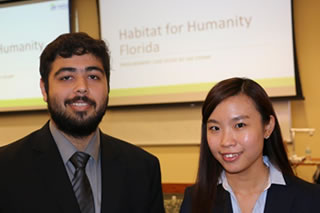News Archive
Marketing and Supply Chain Students Research Habitat for Humanity Procedures, Present Options That Could Save Hundreds of Thousands of Dollars Annually
By Keith Morelli

TAMPA (February, 22, 2018) -- An exhaustive study of Habitat for Humanity procurement procedures conducted by marketing and supply chain students in the Muma College of Business may lead to more homes being built for the Florida needy.
The students presented options last week to Habitat for Humanity Florida CEO Barbara Inman. The study's findings reveal ways to reduce the costs of materials, which potentially could save enough to increase the number of homes constructed each year. Currently, the nonprofit builds about 500 homes a year in Florida for the disadvantaged.
Nine graduate and undergraduate students pored over data provided by 11 Habitat for Humanity affiliates from across the state.
"It took us almost eight months; we started last summer," said a team member Jewel Huang, who is pursuing an MBA with a concentration in supply chain management and a master's degree in business analytics and information systems. "It was complicated."
Getting data was not as easy as initially believed, she said. Only 11 of 57 affiliates opened their books to the students. And much of that came on paper, not in a digital format. Some spreadsheets were photo copies and difficult to read and some contained information that clouded the numbers the students were really looking for.
"Cleaning up the data," Huang said, "was the challenging part."
The students found that Habitat for Humanity's affiliates around the state bought materials from a wide variety of vendors, said Hassaan Mujahid, a graduate student pursuing an MBA with a concentration in supply chain management.
"All had different price pools and everybody used different prices," he said. The students' research, he said, shed light on "a high potential for savings."
The research project examined three different ways to procure materials and presented the options to Inman on Friday evening. The options included making no changes and continuing with the decentralized method of purchasing materials, centralizing all purchasing to obtain lower prices or do a hybrid model which utilizes the best practices of both methods.
Currently, Habitat for Humanity in Florida makes purchases in a decentralized model, meaning each affiliate around the state does its own procurement for house-building materials. This, at times, is advantageous because affiliates are familiar with their own suppliers and decentralization offers more autonomy for each affiliate.
The centralized purchasing model, which takes away that autonomy in favor of purchasing materials from one centralized location, would allow Habitat for Humanity, at least on paper, to get the most value for its home-building operations. With these savings, the nonprofit may be able to stretch its spending budget and build more homes annually, or make homes less costly. It does take some of the autonomy from the affiliates, who no longer could work out deals with their own suppliers.
In the end, the students recommended a hybrid model, utilizing both decentralized and centralized purchasing methods.
"With a hybrid method, some critical purchasing could stay decentralized while other non-critical purchases are managed through a central location or manager," according to the recommendation presented by the students.
"Our students have painstakingly studied the data and recommended a hybrid model of centralized and decentralized purchasing," said Kerry Walsh, faculty advisor of the USF Council of Supply Chain Management Professionals Student Roundtable, of which the students are members. "This could result in Habitat for Humanity being able to build more houses for those in need."
Inman has asked the students to share their findings with several Habitat for Humanity CEOs, not only around the state, but also across the nation as well.
"Habitat for Humanity of Florida is extremely appreciative of the work done by the CSCMP group for USF," Inman said. "To say that they were dedicated to understanding this problem would be an understatement; there were emails that we received in the wee hours of the night."
She said her organization will take action based on the options presented by the students. Specifically, she plans to:
- Share the results with the board of directors and then more widely within Habitat affiliates in the state, and even across other states.
- Invite affiliates and some outside experts in construction to work on a plan to implement as much of the centralized purchasing as can be done, focusing on the highest return items first, such as cabinets, roofing tiles and concrete.
- Schedule another presentation of this material for a wider Habitat audience. There are more than 1,000 Habitat employees in Florida and many more board members and volunteers.
- Engage another study to help us further determine direction.
"The team's research to derive to a conclusion about the most optimal way for Habitat affiliates across the state to purchase materials," Inman said, "was very thorough."